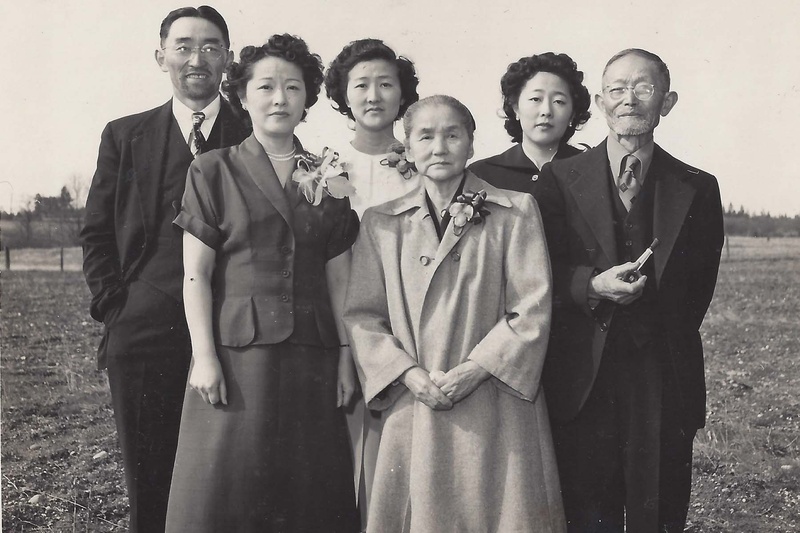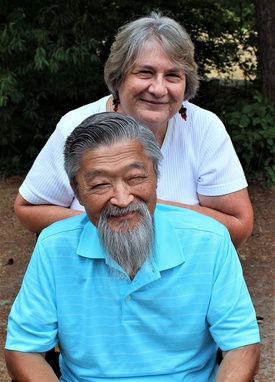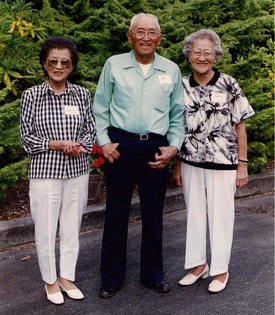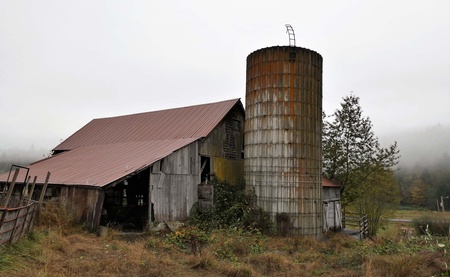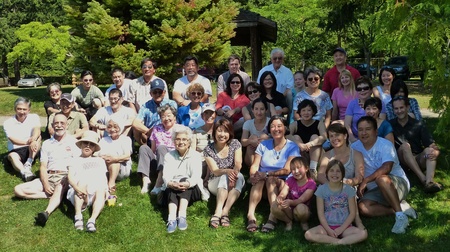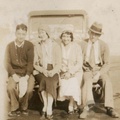Because of his injury, Joe decided he needed another line of work in addition to farming, so he became a realtor. He, Jean and Ray continued to run the farm. Their collective hard work led to Joe winning Jefferson County’s Conservation Farmer of the Year award in 1962.
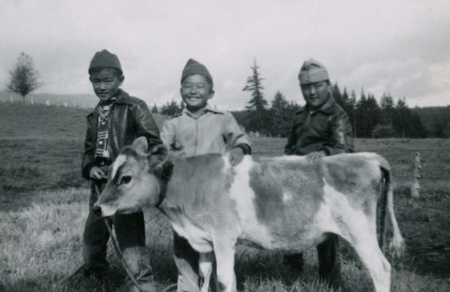
In the meantime, Itsuno had passed away in 1958 at the age of 81. Kaichi lived for two more years, still slender, mentally alert, and active, until his last illness. He was 87.
After two years in community college, Ray joined the military, serving in intelligence in Turkey and Germany. With Ray away, his parents decided that the demands of maintaining dairy cows were too heavy for just the two of them. They quit dairy farming in 1967, electing to raise beef cattle instead.
Joe was also active in the community. He served two terms on the Quilcene School Board and was a director of the Federal Land Bank Association. He was a supervisor of the Jefferson County Soil and Water Conservation District and served as a member of the Washington Milk Producers Association and the Jefferson County Dairy Herd Improvement Association. He was also a Grange Master of the Jefferson County Pomona Grange (a farmers’ association) and of the Quilcene Grange. He had been a Grange member for 50 years.
After Ray returned to civilian life, he got married in 1970. He and his wife, Margie, lived in Auburn with their three children, Tony, Heather and Jeanna. Tony and Heather enjoyed spending summers at their grandparents’ farm for many years.
Eddie and Jeanette Otsuka continued to manage Seattle apartment buildings until they retired. After Eddie’s death in 1977, Jeanette kept herself busy with friends, gardening and travel. I never knew where she’d be until I’d get a postcard, maybe from Cuba, Barrow, Alaska, or somewhere else exotic.
After WWII, Pauline Nakata gave birth to the couple’s last son, Vern. Her husband, John, bought back the grocery store he had sold before going to camp. The store was the precursor to Town & Country Markets, co-founded in 1957 by John, his brother Mo, and a Croatian American friend. That store became the flagship store for a regional chain of supermarkets headed by John and Pauline’s son Don until his untimely death in 2000.
Phil and Alice Okano moved to Seattle, and in 1956 to Bainbridge Island, where Alice did alterations and waited on customers at Phil’s dry-cleaning shop. The couple adopted three children, Joel (who died in infancy), Mike and me. Sadly, Alice passed away in 1967.
1983 promised to be an exciting year for the Kawamoto and Nakata families. October 1 would be the 50th year since the double wedding of Joe and Jean and John and Pauline. A double golden anniversary celebration was planned for them. Unfortunately, in July, Jean passed away in her sleep. The anniversary celebration was never held.
Joe never remarried, although it seemed that many local women would have been happy to be his wife. He did make at least one concession to Jean no longer being there. All the farm dogs that the Kawamotos had ever had had been working dogs. They lived outside and if the weather was inclement, they slept in the barn. Joe began letting Shadow, his handsome Australian shepherd, into the house at night.
The farm has been described as “picture perfect” more than once. Milton Bradley certainly must have thought so, because in 1992, much to the Kawamotos’ surprise, the game company issued a 2000-piece jigsaw puzzle of the farm at hay baling time. Had a friend not seen it in a toy shop and alerted the family, they would never have known.
Joe passed away in 1993. The Port Townsend Leader published his obituary, but more than that, it also published an editorial that read in part:
“In everyone’s life, there should be a friend like Joe Kawamoto. He spent a lifetime — 86 years — among us working the timber harvests in his younger years, the family farmland since 1930. He was the consummate conservator, a land steward with a conscience.”
Pauline passed away in 1997, Jeanette in 2001.
Because their youngest child was still in school, Ray and Margie did not move to the farm until the late 1990s. Like the two generations before them, they became part of the Leland/Quilcene community. For many years, Ray commuted to his job in Fife, though the travel was taxing. Ray initially continued his father’s business of raising beef cattle. Later, he and his business partner turned to a smaller breed of cattle used in rodeos.
The End of an Era, and the Start of a New One
After several years of ill health, Ray passed away in 2016. Margie was unable to run the farm on her own and their children had careers outside of farming. She eventually decided to sell the property. But first, she, Tony and Heather decided to investigate whether the farm could be preserved. Margie had her realtor, the Munn brothers, contact Jefferson Land Trust to see if they might be interested before she put it on the open market.
Jefferson Land Trust’s mission is to work with the community to preserve open space, working lands and habitat forever. After visiting the farm and learning about its historic value, the Trust determined that it was indeed a property worth protecting. Thanks to generous private donors and funding from the Navy’s Readiness and Environmental Protection Integration Program, the Land Trust was able to purchase two conservation easements on the farm.
One limits development; one guides land and forest management, protects water quality and habitat, and makes provisions for interpretive signage at the farm to honor its history and future. The Land Trust collaboration ensures that the farm’s 149 acres, including working forestland and other wildlife habitat, continue to be available as farmland and that the heritage of the Kawamoto family lives on forever.
In fall 2021, Jefferson LandWorks Collaborative, of which the Land Trust is a member, issued a request for proposals offering farmers the opportunity to buy the land at a significantly reduced price owing to the conservation easements. Sixty-five separate parties responded and were invited to two open houses at the farm. More than 120 people attended, and applicants were invited to submit full proposals.
The Selection Committee, which included Heather Kawamoto—Ray and Margie’s daughter—thoughtfully and rigorously evaluated the proposals, addressing farming experience, business plans, financing feasibility, land use and stewardship, community engagement and equitable opportunity. After extensive discussions, including in-depth conversations with five finalist groups, the final selection was made before year’s end.
In 2022, the new owners were announced—a farming collective composed of Ana Galvis, her adult son, Juan D. Castrillon Galvis, Brent Walker, and Natalia Pinzón. Ana, Juan, and Natalia are from Colombia, although they have lived in the US for quite some time. Ana, Brent and Natalia all have degrees in agriculture-related fields and extensive farming experience. The farm is now known as the Kawamoto-Wipala Farm.
On a rainy day in November 2022, a party was held at the farm to welcome Brent and Ana to the community. My cousin, Vern Nakata, my brother, Mike Okano, my partner, Dick Birnbaum, and I joined two of Ray’s children, Heather and Tony, for the festivities. Fittingly, representatives of the Munn family, whose ancestor gave Kaichi his first job in Leland 120 years ago, had helped Brent and Ana prepare the grounds for the party.
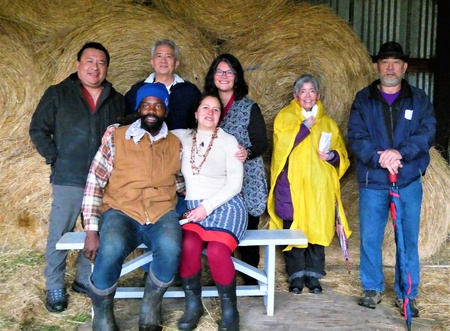
Ana has since become primarily responsible for the farm. A great deal of work must be done to clear the fields of weeds and to restore its buildings, including the house and barn. Although the barn meets the criteria for applying for National Historic Landmark status, pursuing it would require that the grantees provide additional matching funding. It would also come with significant restrictions on the barn’s use that would limit its feasibility for an environmentally friendly farm operation.
For now, Ana hopes to continue producing hay, is raising a few goats, and is experimenting with dryland farming (farming without irrigation). In the long run, if all goes well, she hopes to grow fruit and vegetables, establish an apprentice program, and offer both eco- and agro-tourism.
An especially important part of the Jefferson Land Trust collaboration with Kawamoto-Wipala Farm and the Kawamoto family is the future creation of an interactive educational display. The display will share the history of the farm including the original Native American stewards of the land, the family immigration stories, and the historic journeys of generations past and present.
The Kawamoto farm era that lasted 103 years is now intertwined with a new era for the farm. Ray Kawamoto once expressed the wish that his family’s property be preserved. His aunt, Jeanette Otsuka, had also shared that sentiment. I have no doubt that Joe, Pauline, and Alice would have agreed. Kaichi and Itsuno? They might have wondered what all the fuss was about, but I like to think that deep down inside, they’d be thrilled too.
The family’s best wishes go to the new owners: “Ganbatte kudasai.”
*The last lingering question raised by this essay is, "What is the Wipala in the current Kawamoto-Wipala Farm name? A Wipala is the multi-square emblem that represents the native people of the Andes. Commonly displayed today as a flag, it dates from antiquity.
|
Kaichi & Itsuno (Ueno) Kawamoto Partial Family Tree Joe (Jean Nakata) Jeanette (Eddie Otsuka) Pauline (John Nakata) Alice (Philip Okano) |
*This article was originally published in The North American Post on October 13, 2023.
© 2023 Pamela A. Okano


